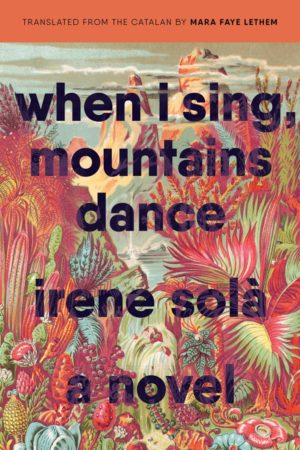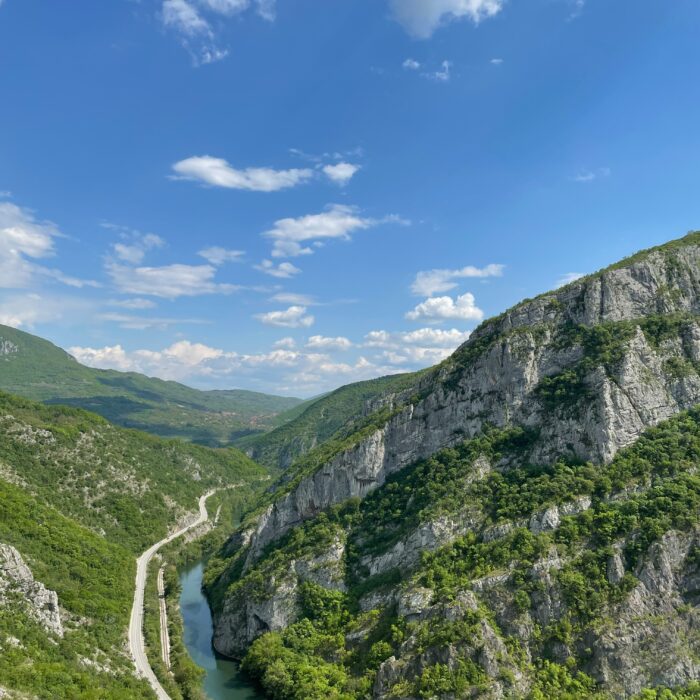You have no items in your cart. Want to get some nice things?
Go shopping
When I Sing, Mountains Dance by Irene Solà has an intriguing title. Straight off, I wanted to discover how the lyrical sentence on the book’s cover related to the narrative. What I discovered was that the improbable image of dancing mountains is perfect for the exquisite story that unfolds.
Translated from the Catalan by Mara Faye Lethem, the book’s title is taken from the last line of a poem written by one of the novel’s narrators, Hilari. The line evokes an image of the poet using their voice to create movement, as illustrated in the final eight lines of his poem.
“I sing like someone plowing a garden,
Like someone carving a table,
Like someone raising a house,
Like someone climbing a hill,
Like someone eating a walnut,
Like someone lighting a fire.
Like God creating animals and plants,
When I sing, mountains dance.”
“Poem for Me, Hilari” is one of several verses composed by the young poet, who like his father before him, composes poetry as he tills the land, never bothering to write any of it down. Hilari is one of many voices telling the story from different points of view. As he explains: “Poetry has to be full like a nightingale. Like morning. Like the thin air at dusk on its way to France. Or not. Or wherever it wants to go. I don’t have anything to write on, anyway, and no pencil.”
Published as Canto Jo I la Muntanya Balla in 2019 by Editorial Anagrama, When I Sing, Mountains Dance is Solà’s second novel. Her first, Ells Dics (The Dams, L’Altra Editorial, 2018), explored the role of the storyteller and how our stories are built. In When I Sing, Mountains Dance, the author has enlarged her perspective, penning a story cycle of death, birth, love, loss, pain, endurance and resilience that is told by eighteen voices, a different one for each chapter. The voices are not necessarily human; plants, animals, the earth, and the weather all conjure different images to weave a tale that encompasses several generations.
An artist and a poet, Solà’s first book of poems Bèstia (Galerada, 2012), was awarded the Amadeu Oller Poetry Prize and has been translated into English as Beast, (Shearsman Books, 2017). Indeed, her lavish use of imagery, sound, movement and color is best when read out loud, and I am sure I am not the only reader to feel compelled to share her prose with anyone sitting nearby.
The narrative begins with the Lightening, which is both the chapter’s title and the narrator’s name:
“After our arrival all was stillness and pressure,” the Lightening tells the reader, “and we forced the thin air down to bedrock, then let loose the first thunderclap.”
Twenty pages and two chapters later, we see the world through the eyes of the widow Siò, who lost her husband in that storm years earlier and now reminisces about their courtship. Solà’s prose here is simply luscious. In Siò’s voice she writes: “I looked at him with glassy eyes, so shiny they shattered. I looked him up and down like a cat that wanted to eat him, full and resplendent, and I parted my lips in a moan so he would press his hand lower on my back, so he would yank me to his chest, and his strong arms would propel the joy out from inside me.”
Siò takes care of the farm and the livestock. She raises their two children and cares for her father-in-law whilst gradually losing her own grip on reality. As the narrative meanders, her children Hilari and Mia tell their own stories, creating a polyphony, in which the plot doesn’t always travel in a straight line. It moves back and forth in time, subtly blending folktales and reality.
Solà was born in the Catalan community of Malo near Barcelona. She chose for the novel’s setting, a remote village in the Pyrenees, approximately a three-hour drive from of Barcelona where she studied Fine Arts. In a short chapter entitled ‘Setting’, a tourist describes the town from the perspective of a Barcelona native, whose dream of eventually retiring to the imagined pastoral setting is described as looking like a picture postcard. The inhabitants, however, are not perceived in such a favorable light. She describes one townsperson as having “a dime a dozen face, a toothless smile and skin so dry you could hear it chafing when he rubbed his nose.” The tourist may be an outsider, but it is through this voice that Solà reveals the reasons for choosing a town steeped in the traditions of earlier centuries as her setting: “Up here time has a different feel. It’s like the hours don’t have the same weight. Like the days aren’t the same length, don’t have the same color, or the same flavor. Time here is different stuff and it has a different value.”
The Catalan language, derived from vulgar Latin in the Middle Ages according to linguists, is in many respects closer to French than Spanish. A language with many vocal flourishes, Lethem’s translation eloquently conveys the power of Solà’s sentences – from the first roe buck who runs with fear at the slightest provocation, to Lluna, Mia’s dog, who eagerly tastes her owner’s food when no one is looking. The black chanterelles, the neighbour, the women labeled as witches – they all have their stories to tell. The various narrative threads interlock and the result is a wonderful novel. Once you’ve finished reading When I Sing, Mountains Dance, you might just want to read it again. It’s that good.
When I Sing, Mountains Dance
By Irene Solà
Translated from the Catalan by Mara Faye Lethem
Graywolf Press, 203 pages

Nadja Maril
Nadja Maril is a former magazine editor and journalist living in Annapolis, Maryland . She has an MFA in Creative Writing from the Stonecoast Program at USM and her short stories and essays have been published in dozens of publications including: Change Seven, Lunch Ticket, Defunkt Magazine and Invisible City Literary Review. She is currently working on a novel and additional credits include weekly blogposts at Nadjamaril.com. Follow her on twitter at SN Maril.
- Web |
- More Posts(2)




